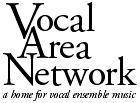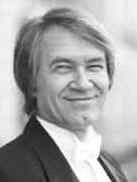 |
 |
Advertise | Sustaining Membership | VAN Store | Feedback
by Tara Anderson for Vocal Area Network
Posted April 28, 2007
 The Russian Chamber Chorus of New York (RCCNY) follows up on its April 2006
program "Parallels and Crossings," which showcased music by familiar Russian composers Tchaikovsky and Shostakovich alongside American composers Samuel Barber and Sarah Dawson, with a sequel: "Parallels and Crossings II: Two Motets and Three Songs."
The Russian Chamber Chorus of New York (RCCNY) follows up on its April 2006
program "Parallels and Crossings," which showcased music by familiar Russian composers Tchaikovsky and Shostakovich alongside American composers Samuel Barber and Sarah Dawson, with a sequel: "Parallels and Crossings II: Two Motets and Three Songs."
Vocal Area Network met with Nikolai Kachanov for an introduction to this year's development of the Parallels and Crossings theme.
Vocal Area Network: What can we expect for this year's program?
Nikolai Kachanov: From last year's nucleus we would like to expand in many directions. Last year I focused on the two basic elements that you can see in our name, the "Russian Chamber Chorus of New York"; thus Russian composers and American composers. But, of course, there is far more diversity than just Russian and American here in New York. And in this program we are celebrating a wider sampling of our extraordinary diversity, and exploring less well-known composers than the famous few.
So this year in addition to less-familiar Russian composers Murov and Sviridov, we will also present music by Latvian, Hungarian, Italian and French as well as American composers. The individual pieces on the program all share the same title of "Two Motets" or "Three Songs." But beneath those simple titles we have amazing contrasts: for example, Debussy's Trois Chansons by Charles D'Orleans juxtaposed with Three Songs by Latvian composer Dambis, following Three Songs of poems by Pushkin by Georgi Sviridov. Similarly, the simple title "Two Motets" conceals an unbelievable wealth of varied material that we will only begin to capture in this program. This diversity that lies within a name is something we especially appreciate in RCCNY because the "Russian" in our name does not mean that we are all Russian and only bring one kind of music to New York. RCCNY is comprised of all stripes of New Yorkers, and our chorus is an instrument that performs all kinds of music in many styles.
VAN: Does the significant diversity in this program present a special challenge for the chorus?
NK: Absolutely, yes. But it is also a wonderful challenge because it helps tremendously to develop the awareness of the chorus to the different sounds and styles needed for different genres. But most importantly we must be able to enter into the world of the most sacred of the sacred: the inner world of the composer. Composers respond to their calling and are committed to express the feelings that stir in them deeply and sincerely -- and with the trepidation and a hope that performers' interpretation will come as close as possible to their creation.
For instance, in Songs of the Sea by Dambis, the composer shares with us a tragic picture from the history of his people. It's difficult for me to imagine that the artists would perform without placing the compositions deeply into their hearts.
Other examples are the most subtle interpretation of Pushkin's poetry by Sviridov in the Three Poems by Pushkin or the powerful warning in the Two Motets by Murov, or the somewhat naive but fiery and sincere call to the highest by the 17th century Italian nun Blanca Maria Meda, of the 17th century in her Two Motets. Or the bright and contrasting piece by Szokolay which contains, within one piece, the journey from Byzantine ornamentation and Gregorian chant to contemporary choral technique.
At the time of creation, a composer is always at the moment of crossing the historical objective and the emotional subjective. It would be unacceptable to perform this program with the same sound throughout. And working with this challenge helps to expand the artistic palette and capability of the chorus.
VAN: Are you concerned about presenting so many relatively unfamiliar composers in one program?
NK: I do recognize that this is a challenging program and demands a special audience. It would be easier to stick with Tchaikovsky and Rachmaninoff, followed by more Tchaikovsky and more Rachmaninoff. But I trust the spirit and willingness of New York audiences to look for and support unfamiliar composers, new sounds and new ideas. And we regard it as our deeply serious mission to not only present these unfamiliar composers, but to bring something special to their work, and give our audience a memorable evening of value.
VAN: On the opposite side of the coin, are you concerned about performing something as familiar as the Debussy Trois Chansons, that is also so decidedly Not Rachmaninoff ?
NK: Yes, this too is a challenge. But I hope that we will be able to bring our own special colors and flavors to the Debussy. It is probably safe to say that when Nijinsky danced the Debussy Afternoon of a Faun with Diaghilev's Ballet Russe that it was a different interpretation from the Walt Disney version with Bambi. This is not to criticize Bambi! But there is room for varied interpretations of even very familiar classics.
VAN: It is a pleasure to see that there will also be a new work from you entitled Three Moods in Blue. Word association from the title suggests Mood Indigo and Rhapsody in Blue. What should we expect here?
NK: I wrote Three Moods in Blue" because I absolutely love jazz. Many years ago, I got into trouble with local officials when I tried to create the first jazz club in my native city of Barnaul in Siberia. Today, jazz is part of the curriculum in music schools! Jazz celebrates close harmony and rhythmic unity. Every moment that we have, whether in performance or in rehearsal, is a special moment to savor the opportunity to make music. Choruses throughout the world become a family that is in many cases closer than one's own relatives. Jazz harmony and its rhythmic togetherness provide a particularly apt way of expressing this closeness. And so to complement the diversity on our program, we would like to share this close harmony and togetherness with our audience.
VAN: Thank you for sharing your thoughts with us. Good luck with your performances!
NK: Thank you.
The Russian Chamber Chorus of New York performs "Parallels and Crossings II: Two Motets and Three Songs" on May 9, 2007 at St. Joseph's Church, 371 Sixth Avenue (between Waverly and Washington Place), and on May 12, 2007 at Holy Trinity Church, 213 West 82nd Street (between Amsterdam Avenue and Broadway). For details, see the VAN Concert Calendar.
Tara Anderson sings with the Russian Chamber Chorus of New York.